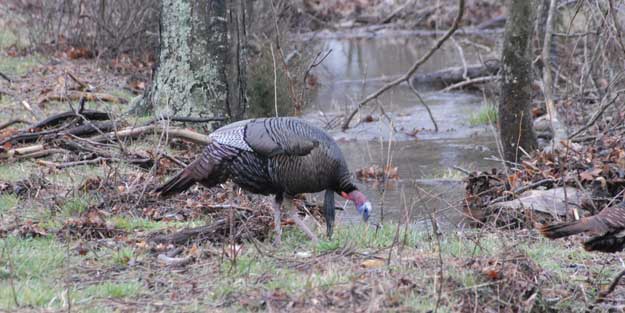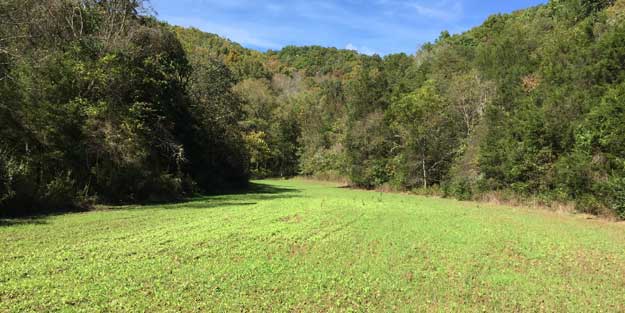Benny Collins | Mossy Oak ProStaff

One of the unique advantages I have by living in Middleburg, Kentucky, is the proximity to Tennessee and Virginia. Within 5 minutes from my home, I can be hunting in any of three states. The big advantage I have during turkey season is that each spring, I have an opportunity to take what we call the Hillbilly Grand Slam or the Redneck Grand Slam of turkeys. If you have licenses to turkey hunt all three states, you can legally take nine gobblers. If you take all nine birds in all three states in one season, we call this the Hillbilly Super Slam. In Tennessee, we can take four gobblers per season, three in Virginia and two in Kentucky.
-
Turkeys Like Dirt
In the early spring, I go back into our green fields and plant wheat for the turkeys. There’s also clover in many of the BioLogic mixes we plant for deer. We leave some of our ground freshly plowed, because turkeys seem to like fresh earth. I’ll see them bugging in the crops we've planted for them and the mature birds dusting in that freshly turned earth where we don’t plant anything. We’re also conscious of leaving brood habitat on the edges of our fields.
We plow up some fields in February too and allow the weeds and native grasses to come up and sprout to create food and habitat for turkey poults. The turkey poults will chase and eat bugs out in these fields, as well as, eat the young tender shoots that begin to come up. These fields that we plow up also provide another place for mature turkeys to dust and get rid of mites and other insects that are irritants to turkeys.
-
DIY Watering Hole
I also create a place for turkeys to water, especially in recent years, since we've had quite a few drought conditions. I go to Walmart, buy some of these little plastic kids’ swimming pools and dig some holes, placing a swimming pool in each hole so that it’s at ground level. Then I shovel dirt around the edge of the swimming pool down in the ground and pack it down. I put a fairly good sized rock in the middle of the swimming pool, and I attach a stick to the rock and put the other end of the stick on the ground outside the pool. This way, if a bird or another animal falls in the swimming pool, it can go to that rock, get out of the water and walk that stick to get back to dry land. I usually put these swimming pools in open fields with bare ground, or where we've planted grain crops. I also put wide sheets of plastic on the side of the hill closest to the swimming pool. At the lower end of the plastic, I bring the plastic together and leave an opening at the end of the plastic where I attach a plastic pipe. This way, when a rain event does occur, the water that hits the plastic funnels down to my plastic pipe and eventually to my swimming pools. This way, we can provide water for turkeys and deer all year long very inexpensively.
I usually have one or two watering spots on each of the farms that I manage, which works especially good during drought times. However, we rarely, if ever, have a drought. The mountains where we have these farms create their own weather. We usually have an abundant rainfall. I can’t remember ever going by one of my swimming pools and seeing it empty of water.
-
Predator Control
One of the biggest limiting factors to turkey populations is ground nest predators. Many years ago, a study done by Auburn University determined that removing ground nest predators will help you have the biggest positive impact on turkey populations on your properties. The easiest predator to remove is dogs. Dogs aren’t nearly as smart as coyotes, and you can trap them in live traps. We put out live trap boxes to catch the dogs living on and coming across our properties. Dogs readily will go into a live trap box trap to get something to eat. When we have a dog in the live trap box, if the dog has a collar with the owner’s name and phone number on it, we call the owner. We explain why we’ve trapped his dog, and why he needs to keep his dog off of our land. When we catch a dog that doesn’t have a collar, we carry the box trap with the dog to the Humane Society or Dog Pound and leave the dog with them.
Next, we get a trapper who has experience trapping coyotes to come in and catch the coyotes, coons and the opossums. The trappers we use will do this type of trapping at no charge, because we give them more land to trap after deer season ends, and turkey season hasn’t begun. Coyotes not only prey on turkey eggs, they’ll kill and eat turkey poults. If they can catch a hen sitting on the nest, they’ll kill and eat the hen and her eggs.
Coyotes aren’t only turkey predators. They also feed heavily on deer fawns. They’ve also been known to kill a doe and eat her and the fawn at the time of birth. After the season, we also allow coon hunters to come on our property and hunt coons, with the understanding that they’ll harvest the coons they tree to help us reduce the coon population.
There are other predators that could be the cause for reduced turkey populations. Predation control is a year-round undertaking and something to always be mindful of.
Mossy Oak is the official camo of the National Wild Turkey Federation. To learn more about the NWTF's conservation efforts, visit http://www.nwtf.org/conservation.



























